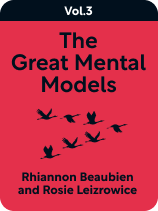

This article is an excerpt from the Shortform book guide to "The Great Mental Models Volume 3" by Rhiannon Beaubien and Rosie Leizrowice. Shortform has the world's best summaries and analyses of books you should be reading.
Like this article? Sign up for a free trial here .
How much of life is random? What can be gained by accepting that randomness?
You could understand anything in the world by learning a finite set of rules and patterns that apply to all aspects of life. That’s the premise of The Great Mental Models series of books from Farnham Street (FS), a website dedicated to timeless knowledge and insightful ideas. The Great Mental Models Volume 3 argues that we can benefit by accepting that most of life is random. The benefits include making better decisions, making fewer prediction errors, and enjoying more creativity.
Keep reading to learn more about what can be gained by understanding the randomness of life.
The Randomness of Life
The model of randomness can help prevent thinking errors by reminding you that sometimes there isn’t a pattern to be found. Authors Rhiannon Beaubien and Rosie Leizrowice argue that most of what happens does so by chance. They say that we don’t realize this because humans constantly try to connect events into stories with clear cause-effect relationships.
(Shortform note: This is known as the narrative fallacy. In Thinking, Fast and Slow, Daniel Kahneman explains that the narrative fallacy occurs because we tend to look for patterns and causal explanations even where none exist. For example, he says that during the German bombing of London during World War II, people suspected that there were German spies housed in unbombed areas of the city—so much was bombed that people assumed the untouched areas must have been left alone for a reason. In fact, Kahneman says, the distribution of bombed and unbombed areas was totally random.)
The idea that the universe is mostly random might seem scary at first, but Beaubien and Leizrowice point out that recognizing the randomness of life has numerous benefits, starting with better decision-making. For example, if you keep in mind that your observations are subject to randomness, you’ll realize that it’s important to have a sufficient number of observations before you draw any conclusions. In the example of wealth distribution above, if you consider only two of the 10 people in the room, you’ll have a totally inaccurate picture of the situation—you might conclude either that everyone in the room makes $30,000 or that half of them make $30,000 and half of them make $2,000,000.
(Shortform note: In Thinking, Fast and Slow, Kahneman argues that this is another way that narrative thinking leads to mistakes: Because we’re quick to make causal links between facts, we can forget to make sure we have a big enough sample to support the conclusion we’ve drawn.)
Understanding randomness also helps you avoid making faulty predictions. The authors point out that a fair coin is equally likely to land on heads or tails on any given flip. That means that even if it comes up heads 10 times in a row, it still has a 50% chance of coming up heads the next time. It can be easy to forget that because we intuitively realize that the odds of flipping heads 10 times in a row are extremely low—1 in 1,024 to be exact. Therefore, when we see 10 heads in a row, we might think the coin is due to come up tails. This mistake is called the gambler’s fallacy—and casinos make big profits off it all the time.
(Shortform note: The gambler’s fallacy is yet another example of our tendency to look for patterns. In Thinking, Fast and Slow, Kahneman points out that the coin flip pattern HTHTTH “looks more random” than HHHTTT or TTTTTT—yet each of these sequences is equally likely when you flip a coin six times. He adds that because the other two patterns look less random, we have more of a desire to understand—and create—a “why” for their occurrence.)
Regression to the Mean
Another lesson we can learn from randomness is that the past doesn’t always predict the future. According to Beaubien and Leizrowice, the principle of regression to the mean suggests that unusual results are most likely to be followed by ordinary results rather than by additional unusual results. For example, in 2021, the average SAT score was 1060. If you randomly sampled 10 test takers from that year and found that those 10 students averaged 1500, it’s most likely that a second random sample of 10 will average much closer to 1060 than 1500.
The reason to keep regression to the mean in mind is that it’s easy to look at a result and construct stories with no basis in reality. For example, if an athlete has a great rookie season followed by a mediocre career, announcers might say that she let early success go to her head, or that the league figured her out, or that she burned out early. In reality, she might simply have had an unusually lucky season followed by years of solid performance at her true skill level. If that’s the case, her apparent dropoff in performance was entirely random.
(Shortform note: Moreover, our tendency to look for correlations among randomness can also lead to faulty understandings of our own behavior. In Thinking, Fast and Slow, Daniel Kahneman points out that it often wrongly appears that punishment leads to improved performance when in fact, the initial poor performance that led to the punishment was a random outlier, and the subsequent “improved” performance would have happened anyway. But if we just notice that punishment is followed by improvement, we might adopt an unnecessarily punitive management style based on this misconception.)
Randomness and Creativity
One final reason Beaubien and Leizrowice say we should embrace randomness is that randomness is at the heart of creativity. We’ve already talked about the fact that we never know where our investments of time and learning will lead us. That’s especially true when it comes to creative activities. The authors point out that novelists often can’t explain where they get their ideas because so much creative inspiration is the result of random chance and the unexpected combinations of prior experience and knowledge. (Shortform note: In fact, there are numerous tools that harness randomness to spark creativity. These tools range from dice based story generators to cards with cryptic instructions designed to help in music production to websites that give random prompts for visual artists.)

———End of Preview———
Like what you just read? Read the rest of the world's best book summary and analysis of Rhiannon Beaubien and Rosie Leizrowice's "The Great Mental Models Volume 3" at Shortform .
Here's what you'll find in our full The Great Mental Models Volume 3 summary :
- How to understand anything in the world by learning a finite set of rules and patterns
- A look at how humans are driven by algorithms
- Why you shouldn't be fooled by randomness






